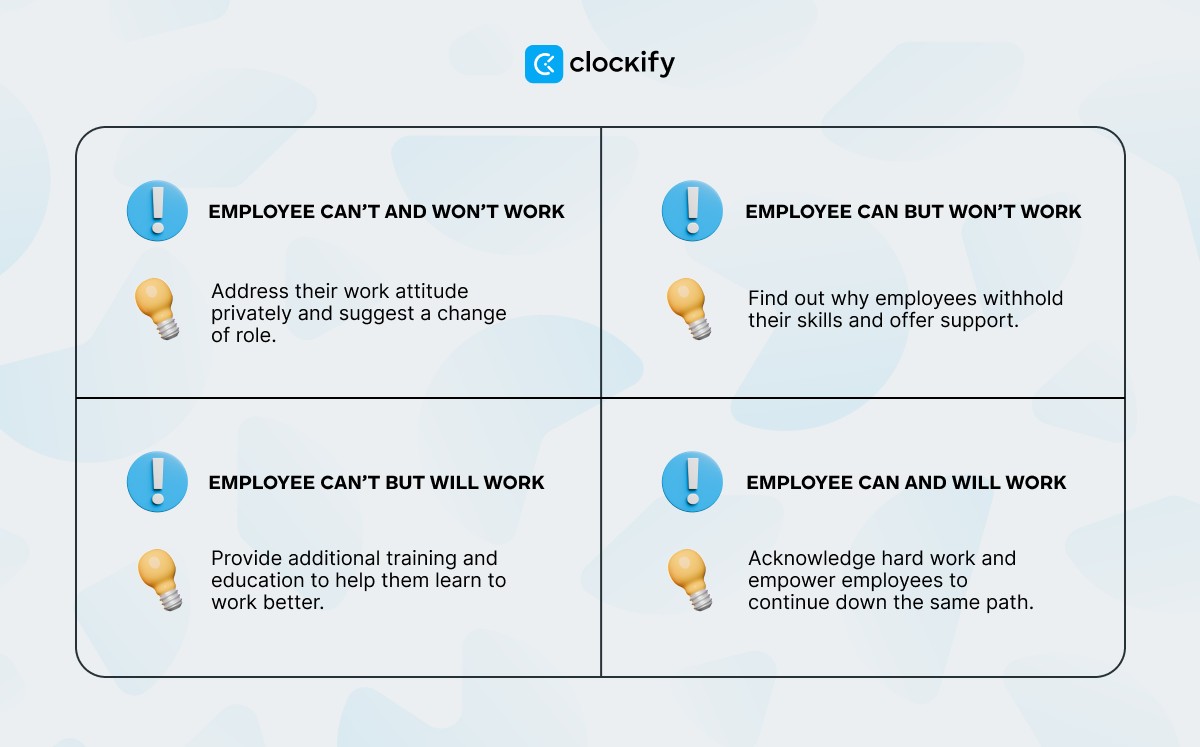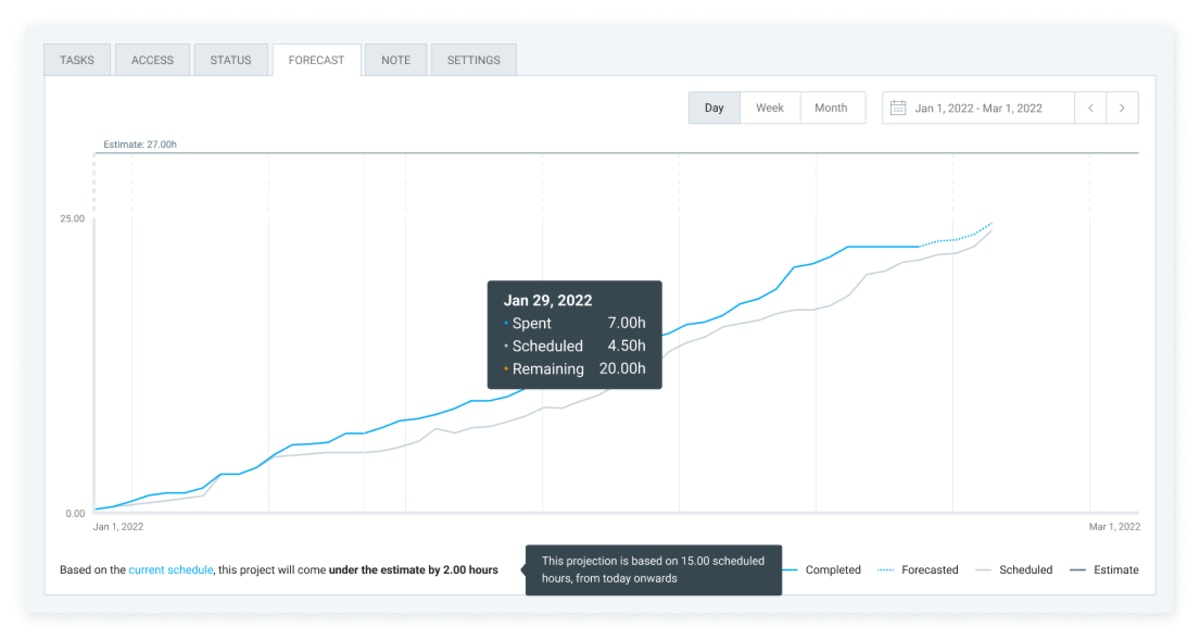Your presence in the office is good for team morale — until you overstay your welcome.
What starts as constructive feedback can quickly turn into nitpicking, making your employees feel tense and insecure.
It’s a red flag for micromanaging.
In this article, we’ll explore common micromanaging examples and how to prevent it for maximum work productivity.

Table of Contents
How to spot a micromanaging boss
Constant task reviews, hovering over desks, and frequent check-ins are all signs of a micromanager.
Though well-meaning, this behavior often creates a stifling work environment where team spirit and productivity can’t thrive.
In fact, experts define micromanagement as the need for excessive control and scrutiny over employees’ activities. Here are several reasons why managers micromanage:
- Perfectionism — setting high standards,
- Lack of trust — questioning employees’ abilities to complete tasks,
- Insecurity and fear of failure — doubting their own skills and micromanaging staff to prevent failure,
- Organizational culture and stress — feeling pressured by upper management to meet goals, and
- Past experiences — shaping their management style based on past experiences.
But who’s prone to micromanagement? Well, it could be anyone in a supervisory role, from team leaders to business owners.
Micromanagement can occur in any work setting — whether in-person or virtually. For instance, holding too many meetings doesn’t depend on the environment, thanks to online communication apps.
Ultimately, micromanagers are ironic figures in the corporate world. Although they aim for efficient leadership, their controlling habits hold them (and their team members) back.
💡 CLOCKIFY PRO TIP
Learn what team productivity means and the best ways to build a productive team.
How is micromanaging toxic?
Despite good intentions, a micromanager’s approach to increasing employee productivity usually backfires.
That’s because workers may see your persistent micromanagement as bullying. The 2 behaviors are similar in their psychological impact on people, as they lead to:
- Mental health issues (like fatigue and burnout),
- Declining motivation,
- Low self-confidence, and
- Fear of jeopardizing their jobs.
Understandably, overmanaging employees can affect their job performance and satisfaction. In fact, a 2022 study on the negative effects of micromanagement shows that subjecting staff to this management style makes them:
- 80.3% less productive,
- 54.5% less satisfied at work, and
- 23.2% more likely to quit.
So, if you pull your employees’ strings too tight, they could snap. Unfair treatment may lead to quiet quitting (doing the bare minimum at work), which could cost your company dearly.
Another sign of toxic management styles is inefficient time management.
Instead of using time tracking to boost productivity, micromanagers misuse the data to interrupt and excessively monitor employees’ work. If you don’t explain how timekeeping benefits your staff and company, it can easily spread fear and stifle creativity.
In contrast, non-toxic management encourages open communication and mutual trust while maintaining a safe environment for employees.
💡 CLOCKIFY PRO TIP
Learn how to build connected teams that thrive on honest communication, open-mindedness, and constructive feedback.
Micromanaging examples in the office
On-site employees often feel they’re more likely to be micromanaged at work than their home-based peers.
It seems logical that remote work would bring more autonomy over tasks — therefore, boosting productivity.
Unfortunately, it’s not so cut and dry.
For illustration, a 2024 US survey on hybrid work explored the biggest workplace concerns among all employee types and concluded that:
- 47% of employees worry about monitored work, and
- 48% of employees worry about the lack of flexibility.
That said, below are some real-life micromanaging examples in traditional work settings.
#1: Business owner Phil Alves believes that involvement in every decision fuels employee insecurity:

“I’ve worked with leaders who wouldn’t let team members make even routine choices without sign-off. This creates a bottleneck where employees feel paralyzed, constantly second-guessing themselves.”
#2: Business leader Cache Merrill thinks requesting constant updates is a micromanaging tactic that hinders employee performance:

“A manager used to ask for updates about a certain task at least 3 times a day. This resulted in poor quality work and high levels of frustration.”
#3: Entrepreneur Kraig Kleeman explains how inefficient time management can stunt business growth and productivity:

“Take, for instance, this CEO I met. His team spent more time checking their work for approval than actually getting things done. This slowed down the company and nobody felt trusted to do their job.”
#4: Business owner Chris Dukich considers the invasion of personal space as a micromanaging practice that causes discomfort among workers:

“Micromanaging often takes the form of hovering over an employee’s shoulder. Such supervision results in delays and unwarranted tension for the employee.”
In short, on-site managers with micromanaging habits tend to cause employee insecurity, reduced efficiency, and hindered company growth.
Micromanaging examples in virtual settings
Remote workers aren’t immune to micromanagement. They face remote work challenges, like having to use monitoring tools, which micromanagers can rely on for extra supervision.
In fact, a global survey on remote and hybrid work shows that, on average, 59% of employees feel that they are micromanaged and surveilled by remote working tools.
In support of these findings, we’ve provided 3 real-world examples of micromanagement in digital environments:
#1: Product marketing leader Seth Geftic notes that micromanagers usually expect constant visibility from remote staff:

“Managers require team members to be constantly online, tracking their time obsessively. This behavior creates an environment of unnecessary stress.”
#2: Business owner Cache Merrill sees hosting frequent online meetings as a remote management practice that disrupts workflow and drives distrust:

“Another example is needing to moderate a video meeting on a day-to-day basis just to gauge the amount of work done so far. Employees feel as though they would not be trusted to complete their tasks without being constantly monitored.”
#3: Business owner Chris Dukich thinks frequently requesting reports for time spent on projects is among common micromanaging examples in the remote workplace:

“Micromanagement often takes the form of hourly and daily work reports, or even reports for every minute spent by any team member on any task for the entire day.”
Overall, managers tend to micromanage remote staff due to limited trust and a need for constant monitoring — resulting in employee stress and a drop in productivity.
How to avoid micromanaging your team
Many micromanagers are unaware of their toxic, unproductive behavior. They believe they’re actually acting responsibly.
Nonetheless, anyone can break their micromanaging habits.
The first step is admitting you have a micromanaging problem. You can tell if you’re guilty of micromanaging by asking for anonymous feedback from your team. That way, you promote honesty and a safe environment.
Another way to avoid micromanaging is by understanding your employees’ skills and what motivates them. This allows you to:
- Support workers in their professional development, and
- Drive productivity in the long haul.

To prevent micromanaging tendencies, put yourself in your employee’s shoes.
For example, you may realize that efficient task delegation isn’t one of your strong suits. To assign tasks effectively, make sure employees understand how their work contributes to company goals, provide clear instructions, and set realistic deadlines. With the right project management practices, you can rebuild trust with your staff.
When used correctly, timekeeping can help you avoid micromanaging. Your employees can learn to love time-tracking if it means you’ll be monitoring their work from a healthy distance. Timekeeping software lets you focus on celebrating accomplishments and promoting autonomy in the workplace.
Let’s reflect: You can lead effectively (without micromanaging) by fostering open communication and mutual trust. Providing positive reinforcement also empowers your team to reach new productivity levels.
💡 CLOCKIFY PRO TIP
Discover how to build a work environment that promotes honesty and manage communication in a virtual setting.
How can employees handle micromanagement?
If you were an employee, how would you deal with a micromanager?
Regardless of the reasons behind the toxic behavior, your employees should feel comfortable discussing it with you.
But what should a conversation with a micromanager address?
When sharing their feelings about being micromanaged at work, your employees should voice their productivity concerns. To resolve these issues, workers can approach the conversation by:
- Demonstrating their commitment to work — pointing out examples of work achievements to discourage distrust or control issues,
- Explaining how micromanagement affects work — describing how micromanagement shifts the focus away from completing tasks,
- Getting more information about assignments — learning about the desired project outcomes to avoid misunderstandings and ensure success,
- Asking for constructive feedback — requesting a performance review so that both sides can share their views, and
- Proposing 1-on-1 meetings — suggesting regular check-ins to rebuild trust and gain more independence.
Based on first-hand experience, entrepreneur Kraig Kleeman believes that being proactive can help employees regain control when dealing with micromanagers:

“Instead of waiting for my boss to ask me for details, I started giving information in advance. I made sure he knew I had the situation under control. It took some tough conversations to set boundaries, but it was worth it.”
To sum up, employees can initiate communication with managers to show their commitment and reduce the likelihood of micromanagement. When discussing toxic practices, workers can recommend constructive solutions to build trust and set boundaries.
Turn micromanagement into efficient leadership with Clockify
If it wasn’t obvious enough, lack of trust is every micromanager’s kryptonite.
Micromanagers often project their insecurities onto employees by constantly scrutinizing their work — which hurts productivity.
As a result, this unintentional yet harmful behavior can lead to inefficient time use and poor project management.
Sounds like you need a confidence boost. Why not try a team productivity tracker?
For instance, affordable time-tracking tools like Clockify help you streamline business operations, reducing your need to get excessively involved in employees’ work.
How so? By offering versatile, flexible, and customizable options that simplify work across different industries.
With the support of our app’s powerful features, your employees can work more autonomously and productively. Meanwhile, you can observe how they spend time to meet performance targets without having to intervene directly — with the help of:
- Reports — get a clear, easy-to-understand analysis of tracked activities for each employee and share reports with your company heads to demonstrate your leadership skills,
- Scheduling — create employee work schedules to prevent overloading staff with tasks, and
- Project forecasting — monitor a project’s progress based on tracked time to better organize your team around company goals.

But what if your employees use multiple tools at work? No problem — Clockify integrates seamlessly with other apps, allowing you to track time spent across various platforms.
With Clockify, you can become a better leader and build a culture of trust and transparency in the workplace.



